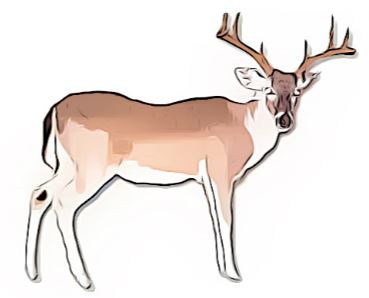
If you have questions about purchasing a license call 1-800-5GO-HUNT.
Harvest management decisions for white-tailed bucks have changed and shifted throughout decades of hunting. Harvesting bucks based on age has quickly become the top management method for buck selection by many hunters in recent years.
This technique uses looking at body features, instead of antlers, to determine if a buck is mature enough to harvest. Although no tow bucks are the same, just like people, you can usually determine if a buck fits in the “young”, “middle-aged”, or “mature” category pretty quickly and easily. Here are some tips and body characteristics to consider for trying to determine each age class:
1.5-year-old buck (yearling) - “Doe with antlers”. Long thin legs with no neck swelling. Less cautious and may be in the vicinity of a doe group. Typically, small antlers with spread inside the ears. Small tarsal area, with no staining during the rut.
2.5-year-old buck - Limited amount of neck swelling, long and lanky legs with slim shoulders. Relative thin long waist with a thicker hindquarter. Antler spread majorly still inside the ears with antlers being 60% of potential. Small tarsal area, with very little staining during the rut.
3.5-year-old buck - Neck is thick and muscled during the rut but still a distinction between the neck and shoulders. Chest region will be deeper than the hindquarters and waist, with a taut back and stomach. 80% of maximum antler potential. Medium tarsal area and staining during the rut.
4.5-year-old buck - Fully muscled neck that blends into the shoulders. Waistline is as deep as the chest. Legs will look proportionate to the body. 90% of maximum antler potential. Large tarsal area with increased staining during the rut.
5.5+-year-old buck (fully mature) - Neck completely blends into the shoulders and legs will appear short for the body. The neck and brisket will appear to be one. Shoulders will look bigger than the rump area. Sagging belly and battle scars are usually evident. 100% of antler potential. Large tarsal area with heavy staining during the rut.
 Overmature - Often are mistaken for younger deer due to decreasing body conditions. Swayed back and a potbelly is common along with loose skin due to lack of muscle. Antler size will typically decline during these age classes for bucks.
Overmature - Often are mistaken for younger deer due to decreasing body conditions. Swayed back and a potbelly is common along with loose skin due to lack of muscle. Antler size will typically decline during these age classes for bucks.
When determining age, it is important to have a broadside view and it’s ideal if he is standing still with his head up.
Time of year should also be considered. A buck’s body will change through the seasons, and can lose 25-30% of their body weight during the rut.
A buck’s behavior can also change his appearance. When a buck is posturing to show dominance his hair will become erect and it will make him look bigger and older. Indications of posturing include ears being laid back, head down, and a stiff walk.